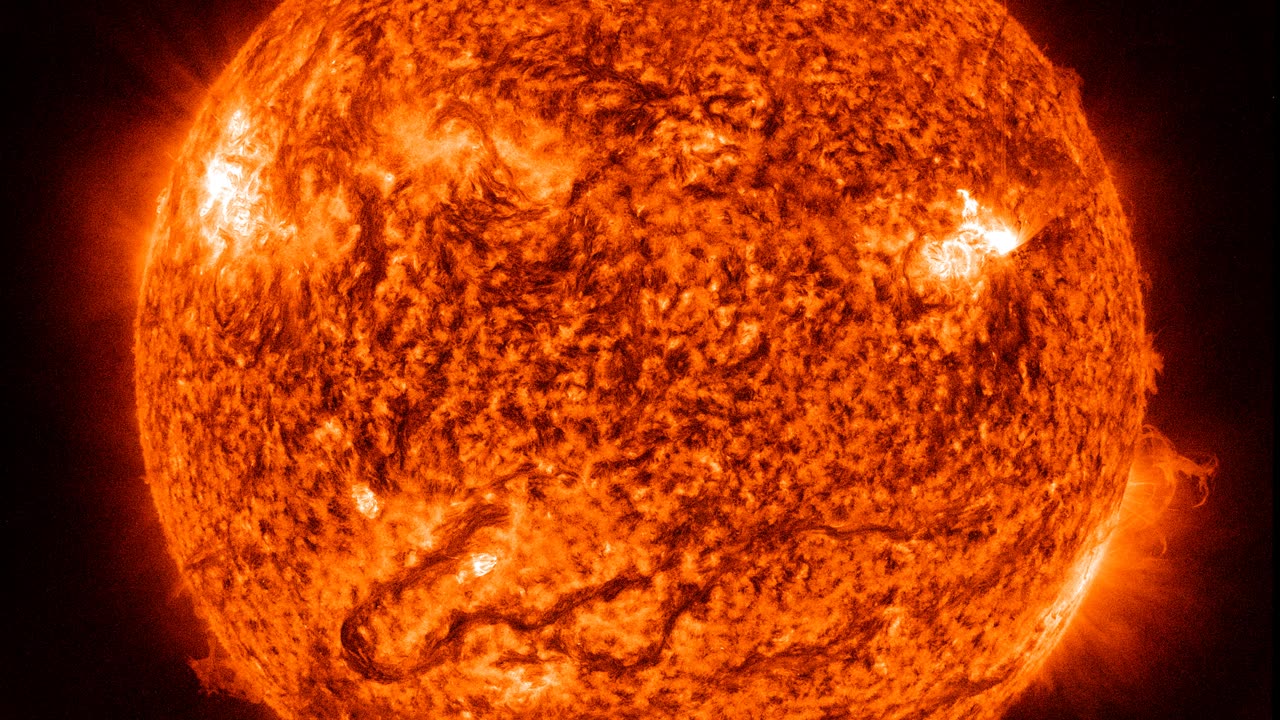Premium Only Content

Solar X-Flare - October 2, 2022 (X1.0 class)
Solar Dynamics Observatory (SDO) operates in a geosynchronous orbit around Earth to obtain a continuous view of the Sun. The particular instrument in this visualization records imagery in the ultraviolet portion of the spectrum at wavelengths normally absorbed by Earth's atmosphere - so we need to observe them from space.
The solar flare as seen in AIA 171 Angstrom filter. Correction is applied for the instrument Point-Spread Function (PSF).
Here we have multi-wavelength views of an X1.0 class flare from early October 2022 (upper right of image). Solar flares are classified by the amount of energy released (Solar Flares: What Does It Take to Be X-Class?). Several long filaments or prominences (the dark ribbons) meander across the lower hemisphere.
What is the PSF (Point Spread-Function)?
Many telescopes, especially reflecting telescopes such as the ones used on SDO (Wikipedia), have internal structures that support various optical components. These components can result in incoming light being scattered to other parts of the image. This can appear in the image as a faint haze, brightening dark areas and dimming bright areas. The point-spread function (Wikipedia) is a measure of how light that would normally be received by a single camera pixel, gets scattered onto other pixels. This is often seen as the "spikes" seen in images of bright stars. For SDO, it manifests as a double-X shape centered over a bright flare (see Sun Emits Third Solar Flare in Two Days). The effect of this scattered light can be computed, and removed, by a process called deconvolution (Wikipedia). This is often a very compute-intensive process which can be sped up by using a computers graphics-processing unit (GPU) for the computation. This video is public domain and along with other supporting visualizations can be downloaded from the Scientific Visualization Studio at: http://svs.gsfc.nasa.gov/13425 NASA's Scientific Visualization Studio/Scott Wiessinger If you liked this video, subscribe to the NASA Goddard YouTube channel: http://www.youtube.com/NASAExplorer Follow NASA’s Goddard Space Flight Center • Instagram http://www.instagram.com/nasagoddard • Twitter http://twitter.com/NASAGoddard • Twitter http://twitter.com/NASAGoddardPix • Facebook: http://www.facebook.com/NASA.GSFC • Flickr http://www.flickr.com/photos/gsfc
-
 12:13
12:13
Russell Brand
1 day agoThe Most Dishonest News Reporting You'll Ever See
63.9K165 -
 39:13
39:13
Rethinking the Dollar
3 hours agoSilver's Flirting With a 12-Year High—Is This the Big Breakout? | Morning Check-In
24K7 -
 15:38
15:38
Professor Nez
2 hours ago🚨LBJ Phone Call to Jackie Kennedy is the WEIRDEST THING I've EVER Heard! JFK Files Analysis
22.3K73 -
 1:26:12
1:26:12
Michael Franzese
17 hours agoTrump Dismantles DOE, Musk Saves Astronauts, Tesla Under Attack | LIVE
32.5K24 -
 5:18:42
5:18:42
EXPBLESS
7 hours agoNEW CLIX SKIN COMING TO THE ITE M SHOP - MAX XP ON FORTNITE
77.4K10 -
 5:19:03
5:19:03
Anvilight
5 hours agoFortnite | Saturday Morning Stream! | Creator Program Day #22
37.7K -
 14:16
14:16
Talk Nerdy Sports - The Ultimate Sports Betting Podcast
4 hours ago3/22/25 - March Madness: Who Wins Today? Vas & Riste Pick Every Game!
33.2K1 -
 3:02:33
3:02:33
RG_GerkClan
6 hours ago🔴LIVE - Lets Dominate this Weekend - Escape From Tarkov - Gerk Clan
51.1K2 -
 4:59:23
4:59:23
SoundBoardLord
7 hours ago90's Saturday Morning Cartoons, Chill Vibes & Great Conversations
43.5K1 -
 13:55
13:55
ThinkStory
1 day ago107 Hidden Clues & Details You Missed In Severance Season 2!
40.9K2